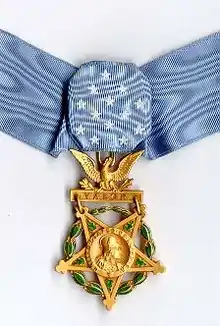James M. Logan
James Marion Logan (December 19, 1920 – October 9, 1999) was an American and former National Guard soldier who was a recipient of the United States military's highest decoration—the Medal of Honor—for his actions in World War II.
James Marion Logan | |
|---|---|
 Medal of Honor | |
| Born | December 19, 1920 McNeil, Texas |
| Died | October 9, 1999 (aged 78) |
| Place of burial | |
| Allegiance | United States of America |
| Service/ | United States Army |
| Years of service | 1936 - 1945 |
| Rank | Technical Sergeant |
| Unit | 3rd Battalion, 142nd Infantry Regiment, 36th Infantry Division |
| Battles/wars | |
| Awards | |
Logan joined the Texas National Guard from Luling, Texas in 1936, at the age of 15.[1] By September 9, 1943 he was serving as a Sergeant in the 142nd Infantry Regiment, 36th Infantry Division. On that day, he participated in the Allied landings near Salerno, Italy. Logan single-handedly captured a German machine gun emplacement and later killed an enemy sniper. For these actions, he was awarded the Medal of Honor ten months later, on July 5, 1944.
Logan reached the rank of technical sergeant before leaving the Army in March and then National Guard in May 1945.[1] He was inducted to the Texas Military Hall of Honor in 1982, and awarded the Texas Legislative Medal of Honor on May 30, 1997.[1][2] He died at age 78 on October 9, 1999 and was buried at the Texas State Cemetery in Austin, Texas.[1]
Awards and Decorations
His decorations include:
![]() Army Presidential Unit Citation
Army Presidential Unit Citation
Medal of Honor citation
Sergeant Logan's official Medal of Honor citation reads:
For conspicuous gallantry and intrepidity at risk of life above and beyond the call of duty in action involving actual conflict on 9 September 1943 in the vicinity of Salerno, Italy. As a rifleman of an infantry company, Sgt. Logan landed with the first wave of the assault echelon on the beaches of the Gulf of Salerno, and after his company had advanced 800 yards inland and taken positions along the forward bank of an irrigation canal, the enemy began a serious counterattack from positions along a rock wall which ran parallel with the canal about 200 yards further inland. Voluntarily exposing himself to the fire of a machinegun located along the rock wall, which sprayed the ground so close to him that he was splattered with dirt and rock splinters from the impact of the bullets, Sgt. Logan killed the first 3 Germans as they came through a gap in the wall. He then attacked the machinegun. As he dashed across the 200 yards of exposed terrain a withering stream of fire followed his advance. Reaching the wall, he crawled along the base, within easy reach of the enemy crouched along the opposite side, until he reached the gun. Jumping up, he shot the 2 gunners down, hurdled the wall, and seized the gun. Swinging it around, he immediately opened fire on the enemy with the remaining ammunition, raking their flight and inflicting further casualties on them as they fled. After smashing the machinegun over the rocks, Sgt. Logan captured an enemy officer and private who were attempting to sneak away. Later in the morning, Sgt. Logan went after a sniper hidden in a house about 150 yards from the company. Again the intrepid Sgt. ran a gauntlet of fire to reach his objective. Shooting the lock off the door, Sgt. Logan kicked it in and shot the sniper who had just reached the bottom of the stairs. The conspicuous gallantry and intrepidity which characterized Sgt. Logan's exploits proved a constant inspiration to all the men of his company, and aided materially in insuring the success of the beachhead at Salerno.
Texas Legislative Medal of Honor
James Logan was the first recipient of the Texas Legislative Medal of Honor on May 30, 1997[3]
See also
References
 This article incorporates public domain material from websites or documents of the United States Army Center of Military History.
This article incorporates public domain material from websites or documents of the United States Army Center of Military History.
- "James M. Logan". Claim to Fame: Medal of Honor recipients. Find a Grave. Retrieved 2008-01-10.
- "Medal of Honor recipients - World War II (G–L)". Medal of Honor citations. United States Army Center of Military History. June 8, 2009. Retrieved 2008-01-10.
